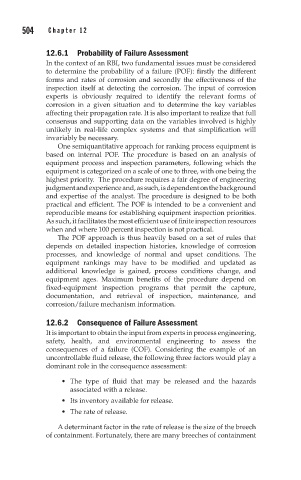Page 538 - Corrosion Engineering Principles and Practice
P. 538
504 C h a p t e r 1 2 C o r r o s i o n a s a R i s k 505
12.6.1 Probability of Failure Assessment
In the context of an RBI, two fundamental issues must be considered
to determine the probability of a failure (POF): firstly the different
forms and rates of corrosion and secondly the effectiveness of the
inspection itself at detecting the corrosion. The input of corrosion
experts is obviously required to identify the relevant forms of
corrosion in a given situation and to determine the key variables
affecting their propagation rate. It is also important to realize that full
consensus and supporting data on the variables involved is highly
unlikely in real-life complex systems and that simplification will
invariably be necessary.
One semiquantitative approach for ranking process equipment is
based on internal POF. The procedure is based on an analysis of
equipment process and inspection parameters, following which the
equipment is categorized on a scale of one to three, with one being the
highest priority. The procedure requires a fair degree of engineering
judgment and experience and, as such, is dependent on the background
and expertise of the analyst. The procedure is designed to be both
practical and efficient. The POF is intended to be a convenient and
reproducible means for establishing equipment inspection priorities.
As such, it facilitates the most efficient use of finite inspection resources
when and where 100 percent inspection is not practical.
The POF approach is thus heavily based on a set of rules that
depends on detailed inspection histories, knowledge of corrosion
processes, and knowledge of normal and upset conditions. The
equipment rankings may have to be modified and updated as
additional knowledge is gained, process conditions change, and
equipment ages. Maximum benefits of the procedure depend on
fixed-equipment inspection programs that permit the capture,
documentation, and retrieval of inspection, maintenance, and
corrosion/failure mechanism information.
12.6.2 Consequence of Failure Assessment
It is important to obtain the input from experts in process engineering,
safety, health, and environmental engineering to assess the
consequences of a failure (COF). Considering the example of an
uncontrollable fluid release, the following three factors would play a
dominant role in the consequence assessment:
• The type of fluid that may be released and the hazards
associated with a release.
• Its inventory available for release.
• The rate of release.
A determinant factor in the rate of release is the size of the breech
of containment. Fortunately, there are many breeches of containment

